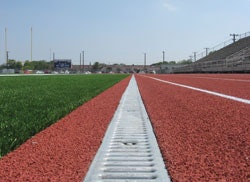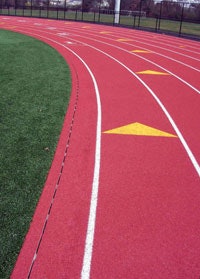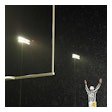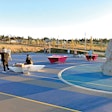Now a standard component of competitive tracks, surface drainage systems come with several design options.
 400-METER MAINTENANCE Removable grates provide access to the subterranean components of a channel drain system at any point along the track.
400-METER MAINTENANCE Removable grates provide access to the subterranean components of a channel drain system at any point along the track.Chris Cucchiara once characterized surface drainage as the Rodney Dangerfield of track construction. It got no respect. "In the old days - and when I say old days, I mean eight or 10 years ago - putting in a full perimeter surface drain was still a new concept," says Cucchiara, product manager with SportsEdge, a drainage manufacturer that focuses the vast majority of its attention on competitive tracks. "Now, it's the standard."
Go back more than 10 years, and infill synthetic turf hadn't yet gained the kind of market traction it enjoys today. Most natural grass fields still featured sizable drainage swales (each complete with a two-foot-square cast-iron grate) between the football sidelines and the inside lane on the surrounding track. This was also about the time soccer was finding a home in just about every available football facility, requiring wider boundaries and bringing into play these potentially dangerous depressions. "You might have a soccer line and then this big catch-basin grate a foot and a half from it," Cucchiara says. "It's a lawsuit waiting to happen, and so surface drainage was becoming a pretty easy sell. It was more concept selling early on to get designers to say, 'You know what? This is antiquated. We can't do this anymore. We need to be using a full perimeter drain.'"
Drains that run the perimeter of synthetic tracks still serve only the track, from which 100 percent of rainwater - aided by an inward slope of roughly 1 degree - runs off. The field will require some form of subsurface drainage, in which the bulk of irrigation percolates through the natural grass or synthetic turf surface.
In fact, the type of field the track surrounds should influence the first track drainage decision. There are two basic types of track surface drainage: channel and slot. The channel system features a U-shaped trough made of polymer concrete and encased in four inches of concrete below grade, where the channel feeds eight evenly spaced catch basins. Each meter-long channel section joins the next in a tongue-and-groove assembly and is accessible from above through a corresponding, meter-long removable grate that can be unlocked and then locked back into position. The galvanized steel grate and surrounding concrete combine to create an ideal six-inch delineation between synthetic tracks and natural grass fields, according to Cucchiara. "You're not only getting your drain system to drain your track, because the track is pitched toward the field, but the concrete encasement around the drain serves as a buffer between the two dissimilar surfaces," he says. "It keeps the grass clippings and sediment a little farther away from your track surface."
The channel itself may be specified at nearly nine inches deep, allowing for adequate drainage capacity even after sediment has accumulated at the bottom of the U.
 MIND THE GAP Providing a clean look to the track surface, a slot drain system must be regularly flushed of debris.
MIND THE GAP Providing a clean look to the track surface, a slot drain system must be regularly flushed of debris.A slot drain appears only as a half-inch-wide gap inside the first lane on the track surface - an even cleaner look for track-specific venues or multipurpose facilities featuring synthetic turf. "If it's a synthetic field, then you can go ahead and use a slotted drain," Cucchiara says. "If it's a natural grass field, we recommend a channel drain with a removable grate system, because the slot drain is a lot harder to maintain long-term. Maintenance doesn't happen on the slotted drain until grass is growing out the top of it."
Infill migration into the slot - and the length of four- or six-inch-diameter PVC pipe capped in polymer concrete that resides below grade - is not much of an issue, Cucchiara adds. That's a good thing, considering access to a slot drain system is limited to its eight catch basins, including three along each straightaway and one centered inside each radius. Each basin measures roughly two meters long by two feet deep and features a removable cover coated with the same material used on the track, save for a single, centered hex bolt that locks the cover in place. Unlike the channel drain, which can be cleaned at any point along a 400-meter track, the slot drain must be flushed every six months with a power washer or high-pressure hose, and debris must be extracted from the catch basins. Says Cucchiara, "If you wait until it's packed full of sediment and debris, then it's almost impossible to clean."
Track designers can also specify a hybrid system, even on natural grass fields, with channel drains running the length of the sidelines and slot drains rounding the radii. A slot drain may also be preferred if the D-zone within a radius is composed of the same material as the track to accommodate field events. "There's a lot of activity in a paved D, and athletes are crossing the drain around the radius all the time," Cucchiara says. "You'll maybe have the high jump going on and you don't want the athletes to feel a grate underfoot."
Installed, a slot-drain system can cost about $40,000, and a channel-drain system between $50,000 and $60,000 - a wise insurance investment considering the surface degradation that results from standing water. A channel drain can also be specified with its own subterranean pitch, requiring extra excavation and sequential installation of numbered U-channels, at an additional cost of $5,000 to $7,000. But the so-called pre-sloped system - installed with some frequency in Texas, less so in California and virtually nowhere else - is completely unnecessary, according to Cucchiara, whose company nonetheless offers one such system to those who demand it. "It's overkill to the 10th power," he says. "With a track, we don't need the extra velocity of flow rate that a pre-sloped system will give you." That's because the mere existence of catch basins every 81 feet creates a gravitational pull on the water in between - even if the channel or pipe is absolutely level. "As the rainfall starts to come into the drain, the water actually forms what's known as a hydraulic grade line," Cucchiara says. "It basically forms its own slope because it's dropping out into that box."
Track drainage is overdesigned for the sole reason that maintenance is too often an afterthought, Cucchiara adds. "When you look at what you're draining - roughly a 30-foot paved area stretching continuously around a 400-meter track - and you do the engineering calculations on hydraulic flow, you'll find that the perimeter drain is way overdesigned as far as what it can handle in the way of rainfall," he says. "But that's okay, because they don't get cleaned out - even the channel drains. You want it to be overdesigned so that it can have two inches of silt in it and still drain 100 percent. When the water hits the track and runs down, it goes over the edge and it's gone."

































